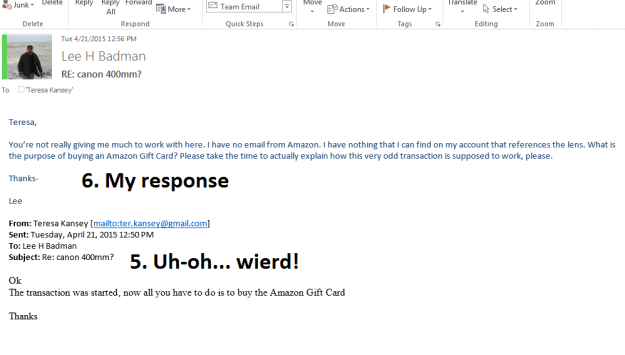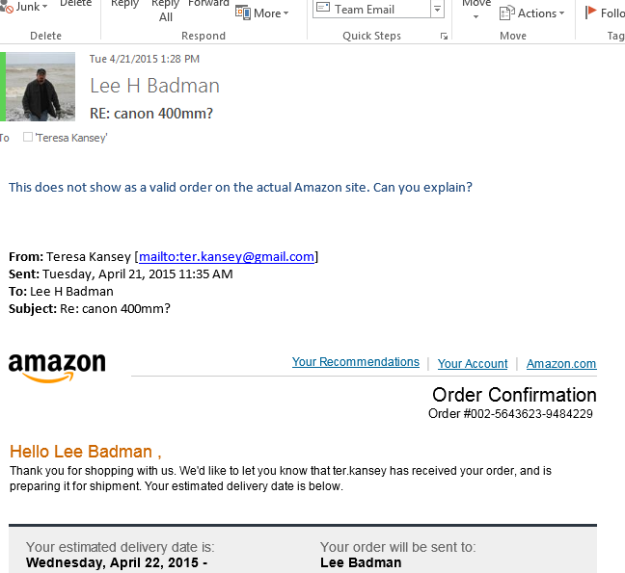I’m sure I’m not alone in admitting that I generally love Amazon. The access to massive product variety, frequently great prices, the whole Prime feature, and a sense that you can really trust the entire framework just makes Amazon easy to appreciate. But that trust thing… well, lately I’ve had it rocked a little bit when it comes to Amazon. Here’s the executive summary:
- I have found multiple clearly fraudulent sellers in the “used” category
- I’ve engaged Amazon’s customer service and investigations staff, had my suspicions confirmed and told by Amazon they’d get rid of the bogus sellers
- The same sellers keep coming back, and they are pretty convincing if you don’t know better
- There seems to be no way for Amazon to keep them out
- Dealing with Amazon in this regard is kind of like talking with children who speak another language, and who also happen to be watching TV or something as you speak to them
Now let’s look at a real-world example.
Please note the instructions for how to engage this seller- you have to leave the Amazon framework and communicate through Gmail. We’ll go there in a bit, but also note the seller’s name “Lin.Martone”. This one has also shown up as:
- LI N Martone
- LinMartone
and each variant has a different gmail account to go with it. On this item, there have been NUMEROUS bogus sellers that come and go, all with the same “email me if you want this” and all with a price that’s too good to be true (hence the draw). All of this has been shared with Amazon via emails and calls. In each case, Amazon agrees fraud is in play, yet it it keeps coming back.
Being a veteran of many an investigation, I decided to follow one of these out before enaging Amazon for the first time. Here we go… bogus seller here is ter.kansey@gmail.com (you’ll love the spoofed Amazon page that’s coming):
Realize- we’ve already broken Amazon’s rules here, by leaving the web framework and communicating directly. The response- a sloppy cut and paste of a reply to somebody named Shane.

Here is where it gets good- sent in my inbox, a very official looking “Amazon page” complete with bogus order number. I have to think that at this point, many shoppers might be fooled.

This person was trying to get me to buy an Amazon gift card, and read them the number as payment for an item that would most assuredly never come. When I called Amazon and shared this all with them, I found a number of challenges in dealing with customer service.
- You can’t share any of these sorts of screenshots- only email headers (which I did)
- When I mentioned fake order numbers and well-crafted fake phishing style pages being provided via email, I don’t know if it even registered with the person I was speaking with
- I pointed out over multiple calls and online reports at least half a dozen bogus “sellers” on this item alone, all with same methodology

- You get the general feeling that Amazon could really care less, and that you are a bit of a bother when you engage them on this over the phone
- The same “sellers” keep coming back
- That anyone can join the Amazon used market as seller and then be allowed to tell customers to go through email and break Amazon’s rules WITHOUT AMAZON THEMSELVES CATCHING IT is bewildering
And that’s it. I’ll still use Amazon for new items, but am thoroughly spooked at how loose and sloppy this end of their used market is. I hope this blog can help even one person not to get scammed by what seems to be pretty common on Amazon.
Cheers!
ADDENDUM- Thanks, Stephen Foskett for taking this issue up on your own blog, and summarizing what to watch out for: (lifted from Stephen):
Here are the hallmarks:
- Too-low round-number prices roughly half the retail cost
- Items sold as used but with specific notes that they’re actually new
- Instructions to email to begin the transaction rather than using the Amazon site, including obviously obfuscated gmail addresses with spaces between letters
- “Just Launched” seller profiles with no ratings
Be careful out there!



















